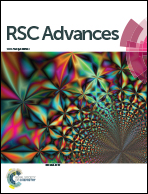Low voltage non-gassing electro-osmotic pump with zeta potential tuned aluminosilicate frits and organic dye electrodes†
Abstract
A novel low-voltage non-gassing electro-osmotic pump using organic-dye electrodes and aluminosilicate frits is demonstrated. Good control of the flow rate is achieved by tuning the zeta potential of the frits in the range of −32.7 mV to −52 mV by varying the aluminum concentration of the aluminosilicate microparticles. The flow rate delivered by the pump is linearly dependent on the zeta potential. The aluminosilicate frits with a maximum zeta potential of −52 mV engendered a maximum flow rate of 27 ± 1.5 μL min−1 V−1 cm−2. In a continuous operation lasting 11 h, the assembled electro-osmotic pump (EOP) can deliver 7.3 mL of a test solution at 60 μA current density. The flow resulted from concerted shifting of protons generated at the anode by electro-oxidation. The consumption of protons at the cathode was accompanied by decomposition of the dye. The non-gassing pump was operated at 0.5 V, which is well below the thermodynamic potential of water electrolysis. The obtained flow rate and pumped volume is sufficient to deliver a bolus of insulin for diabetes management.


 Please wait while we load your content...
Please wait while we load your content...